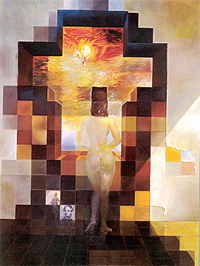| |
|
Figuring out how something works is all about asking the right questions. But one is not always in a position to ask the right question. Sometimes a shift in perspective is needed to see something that was always there, but has been masked by one’s implicit prejudices. Art History is an important perspective to adopt when concerned with figuring out how the visual system works. Visual neuroscience has learned a tremendous amount from the products and practice of artists; indeed artists themselves have often made significant contributions to our understanding of how the visual system functions, both in terms of the basic mechanisms of visual neurobiology and in terms of higher-order processes of psychology. Artists (implicitly) know our visual system well because it is the system they exploit when making art. While it’s true that Leonardo da Vincicouldn’t explain the neural mechanisms underlying the success of his famous work, the Mona Lisa, he demonstrated a profound intuitive sense for how low spatial frequency information communicates important information abou temotional states in a way that high spatial frequency does not. We now knowthat organization of the retina accounts for much of this “DaVinci” effect: the periphery of your visual field is specialized to detect low-spatial frequencies, while your fovea is specialized for high-spatial frequencies.
 "Gala Contemplating
the Mediterranean Sea"
"Gala Contemplating
the Mediterranean Sea"
by Dali (Credit)
Here’s another fun one: Three years after the vision scientists Harmon and Julsez published a block portrait of Abraham Lincoln demonstrating humans’capacity for recognizing faces even at very low resolution, Dali produced Gala Contemplating the Mediterranean Sea, which when seen from 20 meters away becomes the portrait of Abraham Lincoln (Homage to Rothko). This 6.3 x 8.3 ft oil on canvas is two paintings in one. At a distance of no more than 20 meters onlookers observe a back-facing nude gazing through a window onto a harbor. Beyond 20 meters, a second image comes into view: a portrait of Abraham Lincoln. Like the Harmon and Julsez block portrait, which is actually inset at the lower left of the painting, the image of Lincoln is composed ofcolored tiles whose average hue and luminance are analogous to those of the pixels one should find in a low resolution pixilated photograph of Lincoln. Contemporary artist Chuck Close executes a similar feat in his portrait work, but rather than creating one portrait out of another holistic image (like Dail’s Gala), he grids his canvases into tiles that can stand on their own as images or compositions andwhen taken together accomplish the portrait. What Close’s paintings tell us about the psychology of visual perception is useful and surprising: highly detailed features are not necessary to face recognition. Moreover, it is the holistic configuration of features that matters, though researchers are still working to determine which configuration measurements (such as distance between the eyes) are most important and how those spatial relationships are encoded and evaluated. Further,researchers have found that our ability to recognize faces at increasingly low resolution increases with familiarity. Hence, Dali’s choice to depict the iconic image of Abraham Lincoln, one of the most widely familiar faces of his time, contributes to the success of this double image perceptual switching painting.
In the course, Art History is studied through field trips to nearby museums, class discussions, formal analyses, and a class game-show.
|
|
| |
Created by : Kate Ciurej ‘08 and Donna Yee ’11
Created: July 9, 2008
Maintained By: Bevil Conway
Last Modified:July 21, 2013
Expires: July 21, 2013 |